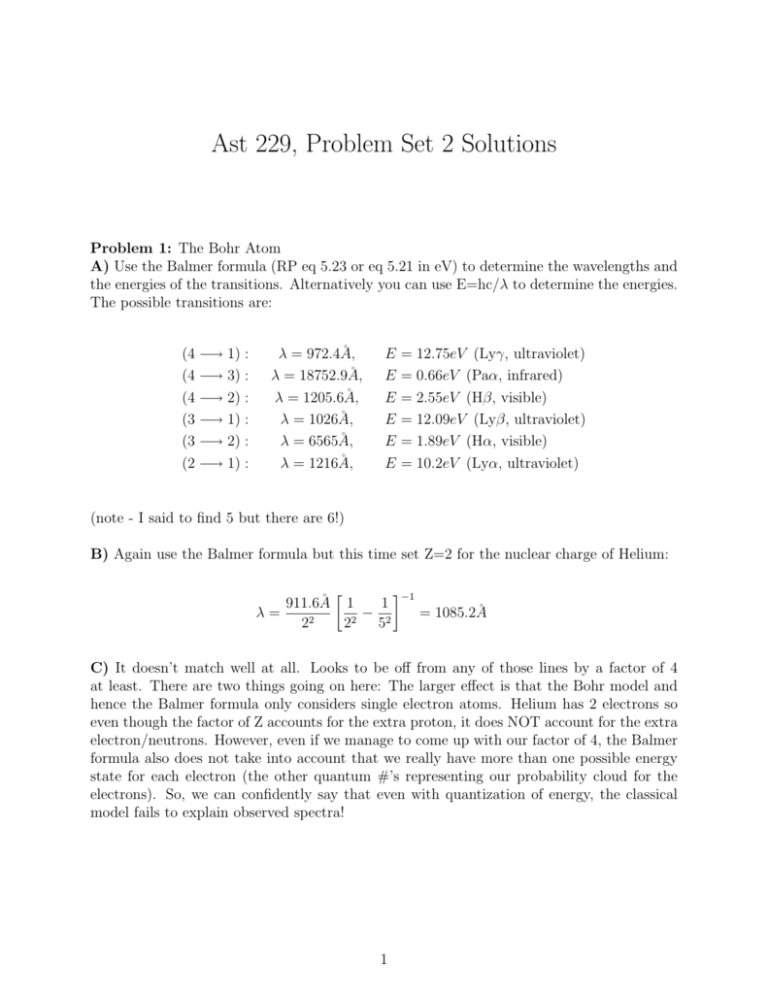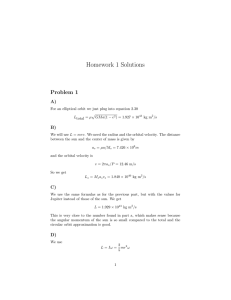HW #3 Solutions
advertisement

Ast 229, Problem Set 2 Solutions Problem 1: The Bohr Atom A) Use the Balmer formula (RP eq 5.23 or eq 5.21 in eV) to determine the wavelengths and the energies of the transitions. Alternatively you can use E=hc/λ to determine the energies. The possible transitions are: (4 −→ 1) : (4 −→ 3) : (4 −→ 2) : (3 −→ 1) : (3 −→ 2) : (2 −→ 1) : λ = 972.4Å, λ = 18752.9Å, λ = 1205.6Å, λ = 1026Å, λ = 6565Å, λ = 1216Å, E E E E E E = 12.75eV (Lyγ, ultraviolet) = 0.66eV (Paα, infrared) = 2.55eV (Hβ, visible) = 12.09eV (Lyβ, ultraviolet) = 1.89eV (Hα, visible) = 10.2eV (Lyα, ultraviolet) (note - I said to find 5 but there are 6!) B) Again use the Balmer formula but this time set Z=2 for the nuclear charge of Helium: −1 1 911.6Å 1 − = 1085.2Å λ= 22 22 52 C) It doesn’t match well at all. Looks to be off from any of those lines by a factor of 4 at least. There are two things going on here: The larger effect is that the Bohr model and hence the Balmer formula only considers single electron atoms. Helium has 2 electrons so even though the factor of Z accounts for the extra proton, it does NOT account for the extra electron/neutrons. However, even if we manage to come up with our factor of 4, the Balmer formula also does not take into account that we really have more than one possible energy state for each electron (the other quantum #’s representing our probability cloud for the electrons). So, we can confidently say that even with quantization of energy, the classical model fails to explain observed spectra! 1 Problem 2: Planck Function in the Limit of Short Wavlengths Begin with the Planck function in terms of λ (as given in RP eq. 5.9 but without the dλ: 2hc2 /λ5 ehc/λkT − 1 Wien’s expression requires that λ is short. Examining Iλ (T ) as λ → 0, we note that the exponential blows up. Therefore, the -1 in the denominator becomes insignificant. For short wavelengths, we can then rewrite Iλ (T ) as Iλ (T ) = Iλ (T ) = 2hc2 λ−5 e−hc/λkT . This is the Wien limit where a = 2hc2 and b=hc/k. Problem 3: Deriving Wien’s law Strategy: Wien’s Displacement Law gives a relationship between λmax and T. Using your calculus knowledge, you know that you can find a maximum in a function by setting the λ = 0 for λ will yield λmax . There are multiple ways derivative equal to zero. So, solving dI dλ to do this derivative (combinations of product rule/quotient rule and chain rule, etc.) It is also perfectly valid to take the derivative and not sub in for x until the end, however, I found it much easier to get to the desired result when doing the substitution as soon as possible. Execution: I use the product rule (d uv = vdu + udv), divide out the multiplicative terms (employing the fact that we are setting the equation equal to zero) and finally substitute for x: dIλ (T ) = dλ 0 0 0 let x = d 2hc2 hc/λkT −1 = (e − 1) dλ λ5 −10hc2 hc/λkT 2hc2 −hc −1 = (e − 1) − 5 (ehc/λkT )(ehc/λkT − 1)−2 6 2 λ λ λ kT 2 −2hc hc/λkT hc hc/λkT hc/λkT −1 −1 = (e − 1) 5− e (e − 1) ) λ6 λkT hc λkT 0 = 5 − xex (ex − 1)−1 xex = 5(ex − 1) Note on Final Form: As some of you pointed out, this is not an equation that is solvable analytically. Rather it must be solved numerically. However, it does happen to be the simplest form of the derivative and a numerical solution will yield Wien’s Law. 2 Problem 4: Since the monochromatic flux is an expression for the flux as a function of wavelength (alternatively expressed as the flux at a single wavelength), if we integrate the flux over all wavelengths, we will obtain an expression for the total flux emitted by a unit area of the star. Begin with an expression for Fλ analagous to RP eq. 5.92 and integrate: Z Fλ = F F F Iλ cosθdΩ = π Iλ Z ∞ Z ∞ 2πhc2 /λ5 = Iλ dλ = dλ ehc/λkT − 1 0 0 −hc ∗∗ hc let u = ; du = 2 dλ λkT λ kT 3 4 4 Z ∞ 4 4 4 u du 2πk T 2πk T π = = 2 3 2 3 u ch e −1 c h 15 0 5 4 2π k = σT 4 , where σ = 15c2 h3 ∗∗ There is a bit of finagling that needs to be done to get the signs to work out. Contrary to appearance, this is not random hand-waving but rather goes back to the original definition of Iλ dλ and the realization that total energy (or luminosity) can NEVER be negative. Because our original definition for Iλ dλ (eq. 5.89 in RP) made use of the absolute value, we must use it again here. If we had left the negative sign in earlier, they would cancel here and our flux would still be positive. (I think Carroll & Ostlie use this method if you are curious.) If questions remain on this point, ask in class! Problem 5: Investigate ”Joe”, the ideal radiator! a) Since luminosity is total energy radiated per second, use the relation L = AσT 4 LJoe = (1.4m2 )(5.67 × 10−8 W/m2 K 4 )(306K)4 = 696 W b) Because Joe is a black body, he will absorb all incident radiation, thus you can use the same relation as in a) Labsorbed = (1.4m2 )(5.67 × 10−8 W/m2 K 4 )(293K)4 = 585 W c) The net energy lost is just the difference between a) and b) = 111 W 3









